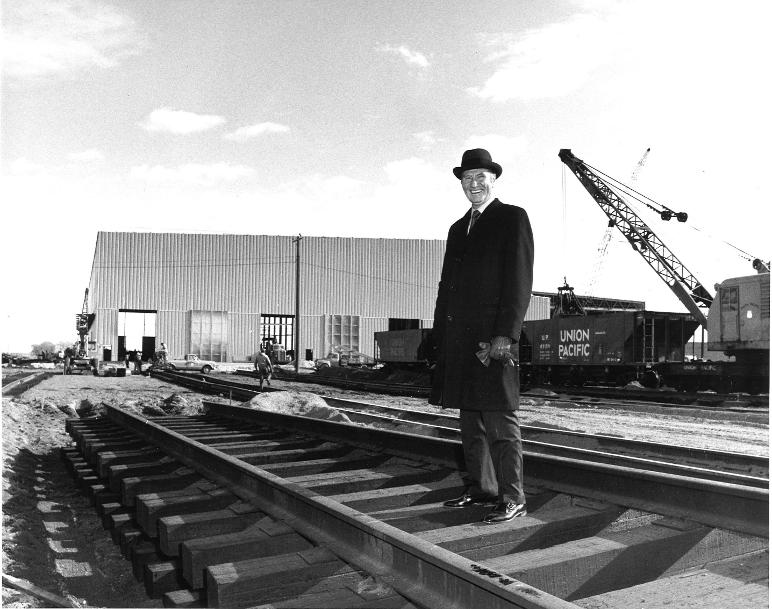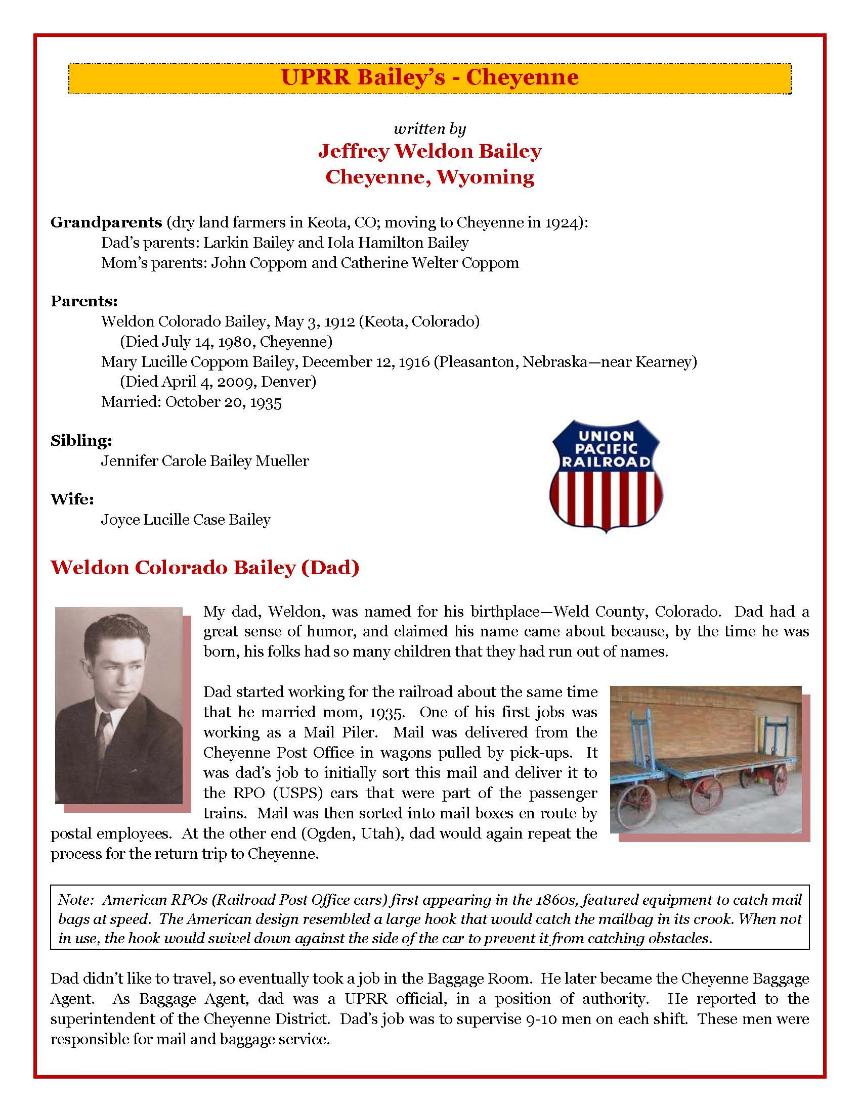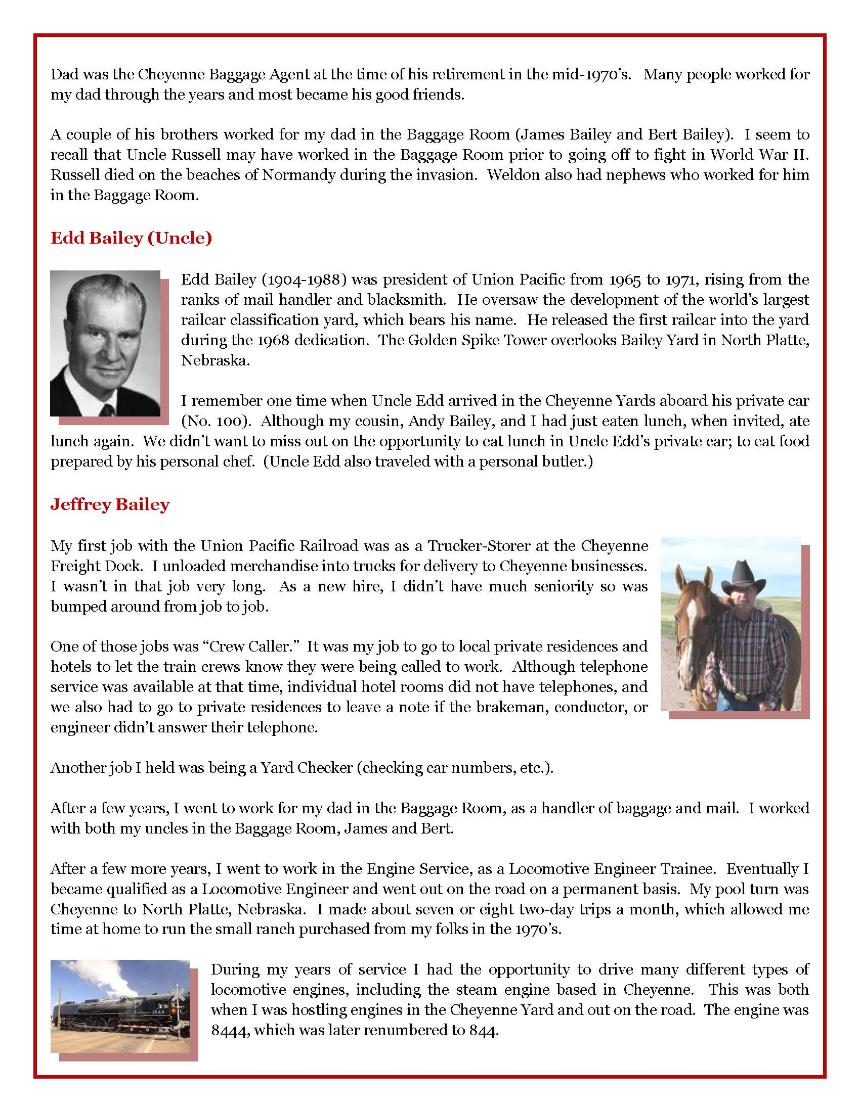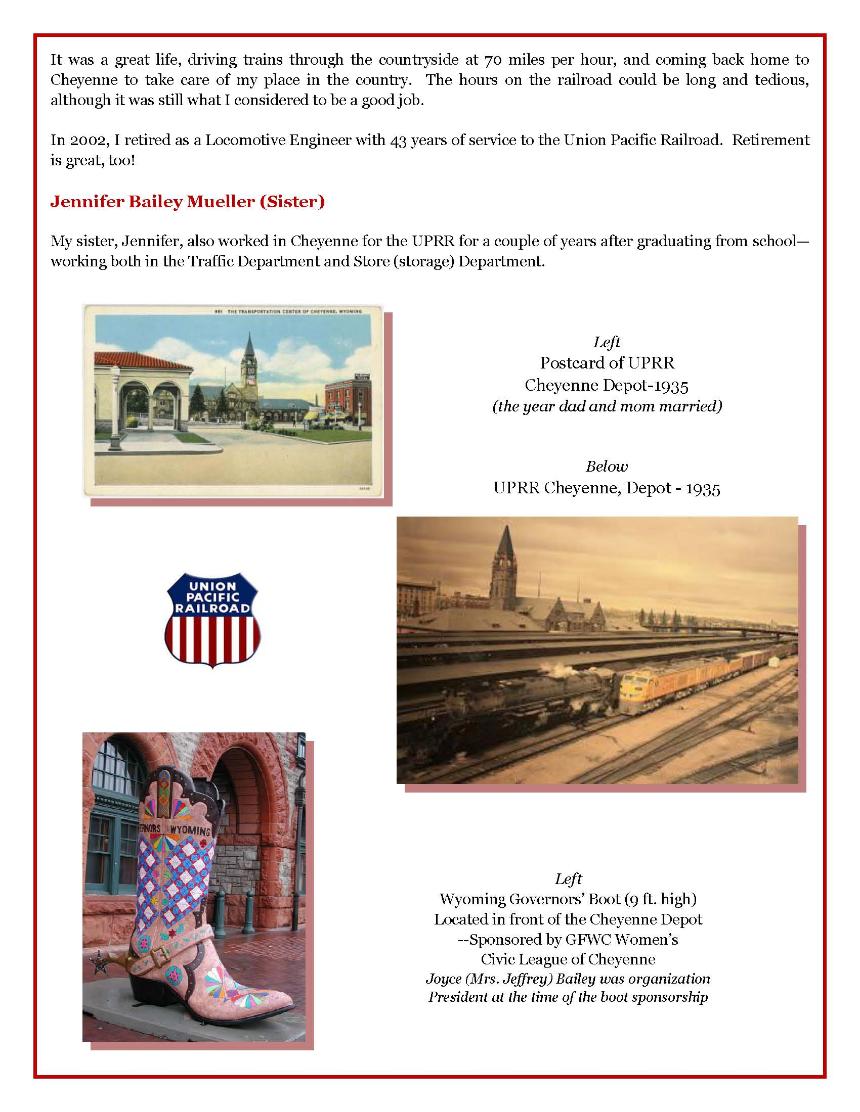
Edd Hamilton Bailey
President of the Union Pacific Railroad
Edd worked as a freight yard blacksmith, loaded mail cars and served as a brakeman, conductor, special police agent and train master. By 1945, Edd Bailey had become superintendent of the railroad's Nebraska and Wyoming divisions. He was appointed vice president in charge of operations in 1957 and seven years later became the executive officer of the railroad's transportation division. Edd would spend 35 years as a general officer for the railroad. In 1965 Edd Bailey was promoted to President of the Union Pacific Railroad. The Bailey Railroad yards in North Platte, Nebraska were named in honor of Edd Bailey. The Bailey yards covers 2,850 acres and is eight miles long.



Harry E. Oswald
Diane Oswald Clark's father, Harry E. Oswald, worked for the UPRR after WWII. He owned a service station on E 16th Street near the Larkin and Iola Bailey home during the 1930's. Harry was drafted into the Army in 1942 and was forced to give up the filling station. His training was at Ft. Hood, Texas, and Harry was assigned as an MP at Fort Francis E. Warren. Daughter Diane Rae Oswald was born there on January 23rd, 1943. Diane and her mother, Lydetta H. Bailey Oswald, lived in the family home at 1906 Cheyenne Place throughout Harry's military service.
After receiving an Honorable Discharge from the Army, Harry went to work for the UPRR before taking a job at Plains Dairy. (Unfortunately, we don't know where he worked at the UPRR in Cheyenne). Harry remained with Plains Dairy until his retirement in 1965. After leaving the Dairy, Harry took a part-time job with the Melton Parking Lot, which later was sold and became the Cheyenne Depot Square. This is the area where those attending the reunion will gather on Friday night for dinner, dancing and musical entertainment UPRR Experience--
Burnill Clark's Railroad Experience--
After graduating from Cheyenne High School in June 1959, I went to work for the UPPR as an IBM Clerk and a Yard Clerk in the Cheyenne Freight Yard. This was at the time when the UP Railroad was getting into computers and had IBM punch cards for each freight car that passed through Cheyenne. As an IBM Clerk I was responsible for creating a punch card for each and every car. Using these cards we then assembled complete trains of loaded and empty railroad cars to be switched together in the freight yard and dispatched to destinations East and West of Cheyenne.
As a Yard Clerk I carried a large battery-powered radio on my back and used a hand-held microphone to communicate information about each railroad car in the yard. As trains would arrive, I would call out the type and number of each car as the train rolled by (sometimes at a speed that made this a challenge). The IBM Clerks inside the Yard House would check the car information and location against printed lists of trains to be certain that every car was correctly accounted for. (To this day when I am stopped at a railroad crossing, I call off the car type and number as the train passes by)!
Working in the Cheyenne yard could be a dangerous job. As a seventeen year-old new employee, my first night on the job was memorable. I met a veteran Carman at the beginning of my shift who introduced me to work in the yard.
Later that evening there was an accident in the yard and I learned that a train this man was working on was moved by a switch engine while the Carman was connecting air hoses. Carmen were to work on these air hoses only when a Blue Light (Lantern) was hung at the beginning and end of a string of railroad cars. Something went wrong and the switch engine moved the cars while the man was working between cars. His legs and part of an arm were cut off by the wheels. Amazingly, this man survived his injuries and lived for many years. With such a vivid safety introduction on my first night, I learned immediately to be very careful working around moving engines and rolling freight cars!
I continued to work for the UPRR for four summers and during the winter holidays. During my Junior year I was "bumped" from my Clerk's job in Cheyenne. So I spent the summer working for the UPRR at the freight house in Sterling Colorado. This gave me a brief introduction to what life on the Eastern Colorado plains was like. It was a hot, dusty summer, and I was thrilled when a position back in Cheyenne was posted that allowed me to "bump" someone and go home. But I did learn to play pool at a local billiard parlor that summer in Sterling!
In the Summer of 1962 I was offered a full-time position with a Denver radio station. I had been working there during the school terms while attending the University of Denver. Since my field of study was radio, television and film, a full-time job in broadcasting was too tempting and I resigned from the UPRR to return to Denver. It was not an easy decision, though, because the union wages paid by the railroad were higher than those paid to radio announcers. I have always had a "love affair" with trains, and it was really hard to give up eating my lunch in the cab of those Big Boy locomotives that were stored in the Cheyenne rail yards. The Big Boy locomotive in Cheyenne's Holliday Park is one of a very few left because the railroad had the dozens of stored steam engines cut into scrap and sold. Each time I see that majestic symbol of the steam era, it brings back many fond memories of my years working in the Cheyenne UP Railroad yards!
Burnill Clark
Rita VanSickle Miller
My grandfather was Art Hamilton, and my mother is Lucille Hamilton VanSickle. She shared with me your information on this summer’s Hamilton Family Reunion in Cheyenne, Wyoming.
Specifically, I would like to respond to your request regarding employment by the Union Pacific Railroad. In 1967, at age 19, I began working at the Union Pacific headquarters building in Omaha, Neb.
After attending college in Maryville, Missouri for 2 years, I was engaged to be married and ready to leave my hometown behind for new adventures in the “big city.” My grandparents suggested a family connection – Edd Bailey, then president of the Union Pacific Railroad.
I recalled a visit to my grandparents’ home near Elmo, Missouri by Edd Bailey and his wife. I remember being extremely impressed by this tall, well-dressed gentleman and his equally gracious and attractive wife. At that time I had no concept of his business stature. Later I learned how he “started at the bottom” and worked his way up to the presidency of the Union Pacific.
I was told that his wife made certain his shirts and clean and ironed every day, regardless of the nature of the many jobs he held over the years with Union Pacific. And I’ve never forgotten that. What a testament to the strong partnership that led these two to be so successful.
It was with some trepidation that I made my way to the big Union Pacific building that day in 1967, announcing myself as a relative of Mr. Bailey. I recall entering his large office, being seated in front of his desk, and asking for a job.
When I think about it now, I’m embarrassed to have been so bold. Whatever Mr. Bailey may have thought, he was very gracious, and I had a job almost immediately. It was a clerking position, tracking movement of rail cars. At that time, cards with punched holes were the high tech method of record keeping. It was amazing to see so many people working on every floor of that large building, and equally amazing to discover the railroad’s impact throughout America.
Although I returned to the Maryville, Missouri area the next year, the example set by Edd Bailey has been a constant motivation throughout my 30-year working career as a journalist. All things are possible if you work hard, have a supportive partner and the faith to reach your goals.